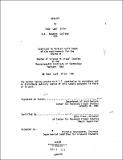Reality
Author(s)
Siler, Todd
DownloadFull printable version (20.39Mb)
Other Contributors
Massachusetts Institute of Technology. Dept. of Architecture.
Advisor
Otto Piene.
Terms of use
Metadata
Show full item recordAbstract
When the Universe first exploded it also imploded simultaneously. In that eternal instance the values of mass and energy were set in some perpetual equilibrium, determining the symmetries of nature. In effect, all that exploded was physical (p), comprising the particle-wavelike nature of matter. In fact, all that imploded was nonphysical (np), making up the virtual particle-wavelike nature of non-matter. Billions of years later, the substance of nonmatter corresponds to the structures and forces of the human mind. In this stage of our mental evolution, it seems apparent the uniqueness of th is np-reality may only be sensed and grasped or known through intuition as interpreted by the arts of the unconscious mind; while the p-reality may only be seen and understood through reason as illustrated or explained by the sciences of the conscious mind. Both forms of consciousness are reflections of the brain functions which appear to be influenced by the one-to-one correspondence of matter and nonmatter. The thought processes and behavior of the human organism, as an extension or a continuum of this correspondence, have evolved with the Universe since its original explosion-implosion event. My intentions are to investigate the p and np realities of the brain and mind, suggesting how certain symmetries such as mirror reflection affect the nature of thought.
Description
Thesis (M.S.V.S.)--Massachusetts Institute of Technology, Dept. of Architecture, 1981. MICROFICHE COPY AVAILABLE IN ARCHIVES AND ROTCH. Bibliography: leaves 144-146.
Date issued
1981Department
Massachusetts Institute of Technology. Department of ArchitecturePublisher
Massachusetts Institute of Technology
Keywords
Architecture.